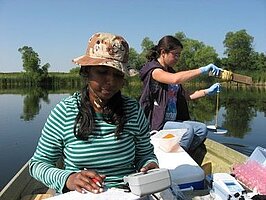Seasonal Succession of Cyanobacteria and Green Algae at Heinrich-Martin Impoundment, North Dakota

Anusha Balangoda is a graduate student (Ph.D.) in Environmental and Conservation Sciences, Department of Civil Engineering at North Dakota State University (NDSU). She completed her B.Sc. in Zoology (major) from University of Ruhuna, Matara, Sri Lanka (2006). Currently my research focuses on seasonal succession of Cyanobacteria and Green Algae at eutrophic fresh water bodies.
Anusha.Balangoda@my.ndsu.edu
Phone: 701-231-8955
Fellow: Anusha Balangoda
Advisor: Dr. Wei Lin, Associate Professor, Department of Civil Engineering North Dakota State University
Degree Progress: PhD in Environmental and Conservation Sciences program, expected in spring 2013
Seasonal Succession of Cyanobacteria and Green Algae at Heinrich-Martin Impoundment, North Dakota
Eutrophication is a process whereby water bodies, such as lakes, estuaries, or slow-moving streams receive excess nutrients (mainly nitrogen and phosphorous). When an ecosystem experiences an increase in nutrients, primary producers reap the benefits first. In aquatic ecosystems, species such as algae experience a population increase (called an algal bloom). Algal blooms limit the sunlight available to bottom-dwelling organisms and cause wide swings in the amount of dissolved oxygen in the water. Oxygen is required by all respiring plants and animals and it is replenished in daylight by photosynthesizing plants and algae. Under eutrophic conditions, dissolved oxygen greatly increases during the day, but is greatly reduced after dark by the respiring algae and by microorganisms that feed on the increasing mass of dead algae.
In North Dakota, major industry is agriculture including production of many crops, farms, and ranches. So the major sources of nutrients (Nitrogen and Phosphorous) loading into the ND’s lake and reservoirs are erosion and runoff from animal feeding operations, and hydrologic modifications. So this excessive level of phosphorous and nitrogen may result in an overstimulation of nuisance algal blooms. According to the seasonal variation when lakes become more eutrophic, with the increase of phytoplankton biomass the diversity of the assemblage decreases ultimately leading to the dominance of cyanobacteria (Blue green algae). Blue-green algal blooms (Harmful Algal Blooms-HABs/Cyanobacteria blooms) produce toxins are poisonous to animal and human health in waters used for recreational and drinking purposes. So in contrast to other phytoplankton, cyanobacteria can withstand under wide range of environmental conditions which is related to their specific growth characteristic features. So eutrophication is not only being a state wise problem it is one of the most widespread environmental problems of inland waters in the world.
Project Objectives:
The main objective of this study is to identify population variation of cyanobacteria and green algae in relation to their growth requirements. The specific objectives of the study are as follows:
- To collect water samples and phytoplankton samples to determine seasonal variation of nutrients level and phytoplankton abundance;
- To determine seasonal variation of total phytoplankton biomass and relative abundance of cyanobacteria; and,
- To analyze chemical and biological data to determine the factors that affect growth of phytoplankton especially seasonal growth and succession of cyanobacteria.
Progress:
The current research is a logical continuation from the ongoing work supported by ND WRRI in 2010. A short progress summary is provided below.
- Water samples were collected on biweekly schedule at each of the four sites throughout the summer 2010. The samples were taken at four depths: 0.5m from the surface, secchi depth, two times secchi depth, and 0.5m from the bottom, at each site. Water samples were analyzed for nutrients (NH4+, NO3 -, NO2-, TP, SRP, TN, and Org P), chl-a, TSS, VSS, and phytoplankton counting and identification. During the sampling period, the calibration methods for several analytical tools (e.g., UV/Visible spectrophotometer, YSI multi parameter sonde, and Turbidity meter) were developed.
- The procedures for nutrients analyses (NH4+, NO3 -, NO2-, TP, SRP, TN, and Org P), analyses for TSS and VSS, and chlorophyll -a were developed. Further, procedures for phytoplankton counting and identification were also developed successfully.
Significance:
By the end of this study I’ll expect to provide detailed information of competitive nature of cyanobacteria and green algae in relation to their growth requirements, tolerances, as well as relative abundance of each group according to seasonal variation. Especially interdisciplinary aspects of biological, chemical and ecological nature of this research are important for understanding of control of cyanobacteria in water resources.
Conference/Seminar Presentations:
North Dakota Water and Pollution Control Conference, 2010. Seasonal Succession of Phytoplankton Population at Heinrich-Martin Impoundment, North Dakota, October 2010. [Poster].

Wei Lin
Civil & Environmental Eng.
Office: Civil/Ind Eng 201D
Telephone: 701-231-6288
Email: wei.lin@ndsu.edu


